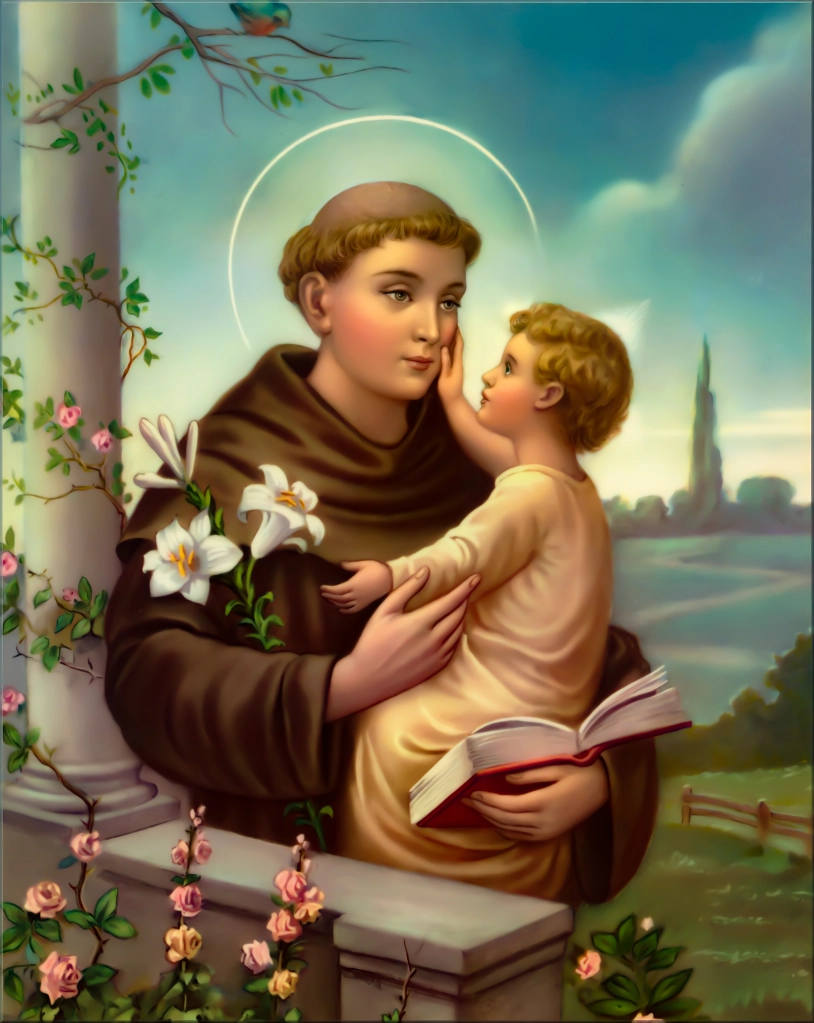
Anthony was baptised as Fernando, the son born in a wealthy family (Firgianche khulliecho in Konkani) of Fernando Martins from Lisbon. At fifteen, he was sent to the Abbey of Santa Cruz in Coimbra, where he learned theology and Latin.
Following his ordination to the priesthood, he was named guest master and was responsible for the Abbey's hospitality. When Franciscan friars settled a small hermitage outside Coimbra dedicated to Saint Anthony of Egypt, Fernando longed to join them. He eventually received permission to leave the Abbey to join the new Franciscan Order in 1220. When he was admitted to this Order, he changed his name to Anthony.
Anthony then travelled to Morocco to spread God's truth but became extremely sick and was returning to Portugal to recover. The ship was blown off-course, and the party arrived in Sicily, from where they travelled to Tuscany. Anthony was assigned to the hermitage of San Paolo after local friars considered his poor health. As he recovered, Anthony spent his time praying and studying.
Miracles of St Anthony
A miracle is a remarkable event that defies natural or scientific rules and is therefore attributed to a Divine agency. St Anthony has performed many miracles during his lifetime, but only a few are recorded. Due to space constraints, only a few are presented here. Once, when Anthony attempted to preach the Gospel of the Catholic Church to heretics in Rimini who would not listen to him, he preached his message to the fish. When critics saw the fish begin to gather, they realised they should also listen to what Anthony had to say.
In another incident in Toulouse, a heresy challenged Anthony to prove the real presence of Christ in the Eucharist. One said, "If you can make my mule submit to what you call the Body of Christ, I will believe." Many people gathered in the city plaza on the day of the demo. After offering mass, Anthony emerged from the chapel carrying the Blessed Sacrament. The starved mule for three days was also brought over and given good fodder. "Mule!" yelled Anthony. Come here and honour your Creator by being respectful. The animal immediately lowered its head and knees in front of the Sacrament. Many heretics, including the mule's owner, were reconciled to the Church.
Aleardino da Salvaterra, a soldier of high honour, had always hated Catholics, thinking they were stupid and gullible. When he was dining, his companions began enthusiastically recounting the numerous miracles that Anthony had done. Aleardino responded by emptying his glass and uttering the following: "If he whom you consider a saint will prevent this glass from breaking when it hits the ground, I will believe everything you are telling me about him." He then tossed the glass to the ground with all of his might, and amazingly, it didn't break, but the tiles on which it landed cracked. As a result of this mysterious phenomenon, Aleardino became convinced and converted.
Leonardo, a young man from Padua, went to St Anthony to confess. He admitted to other misdeeds, including giving his mother a hard kick that resulted in a painful fall. Anthony whispered, "The foot that strikes father or mother deserves to be cut off." He didn't mean for his statements to be taken literally. Unable to comprehend what Anthony had said, he went home, got a hatchet, and hacked off his foot. The news soon reached the ears of Anthony, who rushed to the young man’s house. As he prayed and made the cross while holding the cut foot close to the leg, the foot miraculously attached to the leg. The young man leapt up, offering thanks to Anthony while praising the Lord.
When Anthony died in 1231 and was buried, Cunizza prostrated herself in prayer on the grave. She had a tumour on her shoulder. She was only able to walk by hobbling along with the aid of crutches. A short while later, she realised the swelling had disappeared, leaving her skin smooth and clear. She threw aside her crutches and stood upright, with tears of joy, and she went home giving thanks to God and Anthony.
Anthony was canonised by Pope Gregory IX within a year of his death. Upon exhumation some 336 years after his death, his body was found to be corrupted, yet his tongue was incorrupt, so perfect were the teachings that had been formed upon it.
He is typically depicted with a book and the Infant Jesus. St Anthony is venerated worldwide as the Patron Saint for lost articles, and is credited with many miracles involving lost people, lost things, and even lost spiritual goods. He is the patron saint of amputees, animals, older people, oppressed/poor people, pregnant women, shipwrecks, and many more.
The feast of St Anthony, which is preceded by a 13-day novena known as trezen, is celebrated in many churches and chapels in Goa on June 13, although it is notably grand in Siolim (where he is the patron saint of the main church), at the St Anthony chapel in Goa Velha, Nomoxint (Taleigão) and in Deussua in Chinchinim. It is a tradition to organise a Litany in many homes on this occasion since every Catholic home has an idol of St Anthony on their altar, among other idols. St Anthony pray for us.